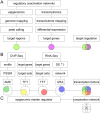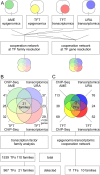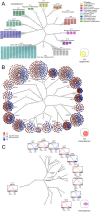A network of epigenomic and transcriptional cooperation encompassing an epigenomic master regulator in cancer
- PMID: 29977600
- PMCID: PMC6026491
- DOI: 10.1038/s41540-018-0061-4
A network of epigenomic and transcriptional cooperation encompassing an epigenomic master regulator in cancer
Abstract
Coordinated experiments focused on transcriptional responses and chromatin states are well-equipped to capture different epigenomic and transcriptomic levels governing the circuitry of a regulatory network. We propose a workflow for the genome-wide identification of epigenomic and transcriptional cooperation to elucidate transcriptional networks in cancer. Gene promoter annotation in combination with network analysis and sequence-resolution of enriched transcriptional motifs in epigenomic data reveals transcription factor families that act synergistically with epigenomic master regulators. By investigating complementary omics levels, a close teamwork of the transcriptional and epigenomic machinery was discovered. The discovered network is tightly connected and surrounds the histone lysine demethylase KDM3A, basic helix-loop-helix factors MYC, HIF1A, and SREBF1, as well as differentiation factors AP1, MYOD1, SP1, MEIS1, ZEB1, and ELK1. In such a cooperative network, one component opens the chromatin, another one recognizes gene-specific DNA motifs, others scaffold between histones, cofactors, and the transcriptional complex. In cancer, due to the ability to team up with transcription factors, epigenetic factors concert mitogenic and metabolic gene networks, claiming the role of a cancer master regulators or epioncogenes. Significantly, specific histone modification patterns are commonly associated with open or closed chromatin states, and are linked to distinct biological outcomes by transcriptional activation or repression. Disruption of patterns of histone modifications is associated with the loss of proliferative control and cancer. There is tremendous therapeutic potential in understanding and targeting histone modification pathways. Thus, investigating cooperation of chromatin remodelers and the transcriptional machinery is not only important for elucidating fundamental mechanisms of chromatin regulation, but also necessary for the design of targeted therapeutics.
Conflict of interest statement
The authors declare no competing interests.All experimental protocols were approved by the Institutional Review Boards at the University of California Merced. The study was carried out as part of IRB UCM13-0025 of the University of California Merced and as part of dbGap ID 5094 for study accession phs000178.v9.p8 on somatic mutations in cancer and conducted in accordance with the Helsinki Declaration of 1975.
Figures





Similar articles
-
The histone demethylase KDM3A regulates the transcriptional program of the androgen receptor in prostate cancer cells.Oncotarget. 2017 May 2;8(18):30328-30343. doi: 10.18632/oncotarget.15681. Oncotarget. 2017. PMID: 28416760 Free PMC article.
-
Transcriptional and Epigenomic Regulation of Adipogenesis.Mol Cell Biol. 2019 May 14;39(11):e00601-18. doi: 10.1128/MCB.00601-18. Print 2019 Jun 1. Mol Cell Biol. 2019. PMID: 30936246 Free PMC article. Review.
-
Global histone modification profiling reveals the epigenomic dynamics during malignant transformation in a four-stage breast cancer model.Clin Epigenetics. 2016 Mar 31;8:34. doi: 10.1186/s13148-016-0201-x. eCollection 2016. Clin Epigenetics. 2016. PMID: 27034728 Free PMC article.
-
'Traffic light rules': Chromatin states direct miRNA-mediated network motifs running by integrating epigenome and regulatome.Biochim Biophys Acta. 2016 Jul;1860(7):1475-88. doi: 10.1016/j.bbagen.2016.04.008. Epub 2016 Apr 14. Biochim Biophys Acta. 2016. PMID: 27091612
-
Crosstalk between epigenetics and metabolism-Yin and Yang of histone demethylases and methyltransferases in cancer.Brief Funct Genomics. 2017 Nov 1;16(6):320-325. doi: 10.1093/bfgp/elx001. Brief Funct Genomics. 2017. PMID: 28369194 Free PMC article. Review.
Cited by
-
CD271 is a molecular switch with divergent roles in melanoma and melanocyte development.Sci Rep. 2019 May 22;9(1):7696. doi: 10.1038/s41598-019-42773-y. Sci Rep. 2019. PMID: 31118427 Free PMC article.
-
The Long Non-Coding RNA SAMMSON Is a Regulator of Chemosensitivity and Metabolic Orientation in MCF-7 Doxorubicin-Resistant Breast Cancer Cells.Biology (Basel). 2021 Nov 9;10(11):1156. doi: 10.3390/biology10111156. Biology (Basel). 2021. PMID: 34827149 Free PMC article.
-
Protein ensembles link genotype to phenotype.PLoS Comput Biol. 2019 Jun 20;15(6):e1006648. doi: 10.1371/journal.pcbi.1006648. eCollection 2019 Jun. PLoS Comput Biol. 2019. PMID: 31220071 Free PMC article. Review.
-
Network Approaches for Charting the Transcriptomic and Epigenetic Landscape of the Developmental Origins of Health and Disease.Genes (Basel). 2022 Apr 26;13(5):764. doi: 10.3390/genes13050764. Genes (Basel). 2022. PMID: 35627149 Free PMC article. Review.
-
KDM6B interacts with TFDP1 to activate P53 signaling in regulating mouse palatogenesis.Elife. 2022 Feb 25;11:e74595. doi: 10.7554/eLife.74595. Elife. 2022. PMID: 35212626 Free PMC article.
References
-
- Filipp FV. Epioncogenes in cancer—identification of epigenomic and transcriptomic cooperation networks by multi-omics integration of ChIP-Seq and RNA-Seq data. Syst. Biol. Methods Mol. Biol. 2019;1800:101–121.
Grants and funding
LinkOut - more resources
Full Text Sources
Other Literature Sources
Molecular Biology Databases

